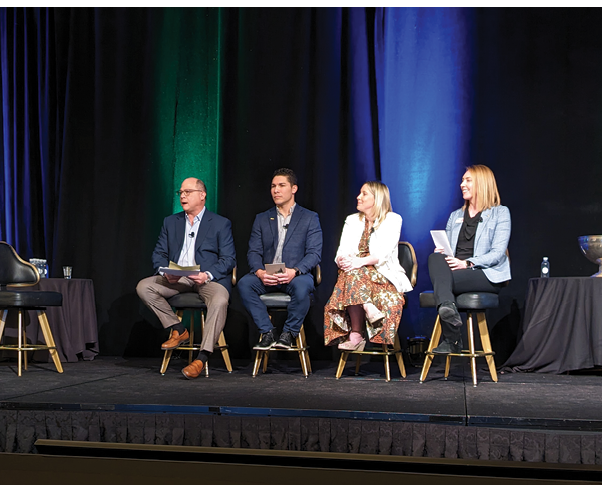Five Ways to Address Generational and Mentorship Gaps
How to train and mentor new employees

Above: From left to right, panelists Jeff Haber of W&W Glass, Joey Aragon of Aragon Construction, Taylor Anderson of Anderson Aluminum, and moderator Sara Neiswanger, NGA.
How do you make time to train and mentor new employees? How do you incentivize workers to stay? Is the next generation ready to take the reins?
These were several key questions addressed by panelists during the panel “Five Ways to Address Generational & Mentorship Gaps” at the recent 25th anniversary BEC Conference in Las Vegas, which drew more than 680 industry participants for two days of industry education. The event was hosted by the National Glass Association and was held March 5-7 at Ceasar’s Palace Las Vegas.
During the panel, leaders from three family glazing businesses—Joey Aragon, director of operations at Aragon Construction; Taylor Anderson, director of marketing for Anderson Aluminum; and Jeff Haber, managing partner at W&W Glass—offered strategies on a range of labor issues, including mentorship, worker retention and ownership transition. Five takeaways from the panel:
- Take time for a big-picture approach. “Make the time to work on the business, not just in the business,” says Anderson. “Focus your efforts on the company’s most important initiatives, set timelines, execute, and follow-up. And determine short-term and long-term goals regarding ownership, transitions, and department initiatives.”
- Prioritize mentorship. Aragon recommended formalizing mentor-mentee partnerships at the company. “This adds excitement for those people and the people around them,” he says. Additionally, Aragon also emphasized that mentorship programs can start small. “Don’t let trying to make something big and in-depth be a barrier to creating a mentorship program. You can do this tomorrow,” he says.
- Develop processes to capture institutional knowledge. Anderson recommends that companies create development programs that can help fill the knowledge and experience gaps between more experienced and newer employees. “Develop opportunities for your more experienced employees to step out of their day-to-day and focus on sharing their knowledge with the next generation,” she says.
- Systemize the feedback process. “When we got on a regimented program for feedback, lightbulbs went off,” says Aragon. The company instituted quarterly conversations. “What’s good about that is it creates a predicable rhythm. Mentors and mentees know it’s coming up ... and everybody has chance to hear feedback.”
- Identify goals for business exit and succession. All company owners should begin to make plans for ownership transition and management succession. “At a certain point you have to decide, what are you going to do,” according to Haber, who discussed his company’s recent transition to an employee stock ownership plan. “Our goal was to seamlessly find a way to not damage the brand equity built up over decades while protecting all the stakeholders—i.e., employees, selling shareholders, customers and the next generation while transferring ownership,” he says.

